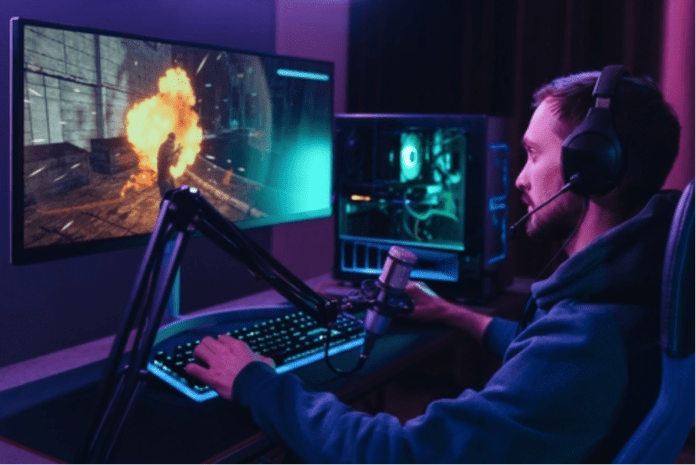Across the vast digital entertainment landscape, competitive gaming has charted an extraordinary evolutionary path, evolving from simple solitary pastimes to complex multiplayer experiences involving millions of players around the world. This metamorphosis not only redefined the concept of gaming, but also pushed technological innovation to new heights, profoundly influencing the hardware and software industry.
What does competitive gaming mean?
Competitive games are video games designed to test players' skills in a structured and regulated environment . These games provide a level playing field where ability, strategy, and teamwork determine success.
Modern competitive games fall into several categories, each with their own particularities and requirements:
- MOBA (Multiplayer Online Battle Arena) : Strategic games where two teams compete to destroy the opposing base, like League of Legends, Dota 2.
- FPS (First-Person Shooter) : First-person shooter games that test precision and reflexes, such as Counter-Strike: Global Offensive, Valorant.
- Battle Royale : Survival games where players compete on large maps, eliminating each other until only one remains, such as Fortnite, Apex Legends , PUBG.
- Fighting games : Games that require precision and extensive knowledge of moves and combos, such as Street Fighter, Tekken .
- RTS (Real-Time Strategy) : Real-time strategy games where players manage resources and units to prevail over the opponent, such as StarCraft II.
From origins to the multiplayer boom

But how did we get to modern competitive gaming? Early competitive games were primarily solitary experiences , where the player challenged themselves or the computer's artificial intelligence. Titles like Pong and Space Invaders laid the foundations for what would become a revolution in gaming, pushing for the development of ever more powerful hardware to support increasingly complex graphics and game mechanics.
With the advent of home consoles and personal computers, competitive gaming began to evolve into local multiplayer experiences . Challenges between friends on games like Street Fighter II or Mario Kart created the foundations of what would become a true competitive culture. The demand for ever more sophisticated controllers and TVs with ever faster response times has become increasingly important to ensure a smooth and responsive gaming experience.
The Internet Age: When Competitive Gaming Brought Down Borders
The arrival of the Internet marked a crucial turning point for competitive gaming. The ability to challenge players from around the world has opened new frontiers, giving rise to genres like MOBA (Multiplayer Online Battle Arena) and online FPS (First-Person Shooter). This evolution has posed new technological challenges, pushing for the development of:
- Low latency networks : essential to ensure a smooth and responsive gaming experience;
- Dedicated servers : necessary to handle the traffic of millions of players simultaneously;
- Advanced security systems : to prevent cheating and ensure a fair gaming environment.
Esports: when gaming becomes a profession

The evolution of competitive gaming led to the birth of esports , transforming gaming into a global phenomenon and a true professional career for many gamers. This has generated new needs in terms of infrastructure and technologies, such as:
- Specialty Arenas : Structures designed to host tournaments with thousands of live spectators.
- Advanced Streaming Systems : Essential for broadcasting events to millions of online viewers around the world.
- Augmented reality technologies : Used to enhance the audience experience with real-time information and data overlaid on the screen.
The influence of technology on competitive gaming

As competitive gaming has evolved, hardware has had to keep pace. Gamers demand peak performance, pushing manufacturers to constantly innovate. Some key elements of modern hardware for competitive gaming include:
- High-performance processors : capable of handling complex game simulations in real time
- Powerful graphics cards
- High refresh rate monitors : for unprecedented gaming fluidity
- Specialty peripherals : mice, keyboards and headsets designed specifically for competitive gaming
The evolution of competitive gaming from single-player to multiplayer is a testament to the transformative power of technology in entertainment. This evolution has driven innovation in areas like hardware, networking, and software, creating an ever-expanding ecosystem that goes far beyond just “video gaming.” As we venture into the future, one thing is certain: competitive gaming will continue to evolve , pushing the boundaries of technology and human imagination. Whether you're a long-time enthusiast or new to the world of competitive gaming, an exciting future awaits you, full of technological innovations and new forms of digital competition.
This progress is not limited to video games, but also concerns industries such as online casinos . These have also evolved to offer ever more immersive experiences and remain competitive in the market. Online casinos like Casino Night , for example, use the best security protocols and have one of the strongest licenses in the iGaming industry to guarantee an excellent gaming experience.
The future of competitive gaming: the challenge of balance
Looking to the future, competitive gaming seems destined to go even further. The new boundaries include:
- Virtual and augmented reality : Promise to take competitive gaming to a new level of immersion;
- Cloud gaming : Could democratize access to competitive gaming, reducing dependence on local hardware;
- 5G and beyond : Ultra-fast networks promise to eliminate latency, making new forms of competitive gameplay possible.
One of the most interesting challenges for the future of competitive gaming will be maintaining a balance between accessibility and competitive depth. On the one hand, there is the need to attract new players with accessible experiences; on the other, the competitive community demands deep and complex game mechanics. While some gamers invest in thousands of dollars' worth of setups to gain even the slightest competitive edge, developers need to ensure their games are also playable on smaller monitors and devices.
An endless evolution
The evolution of competitive games, from solo game to multiplayer, testifies to the transformative power of technology in the field of entertainment. This development has pushed innovation in fields such as hardware, networks and software, creating an expanding ecosystem that goes far beyond the simple "video game". While we are venturing into the future, one thing is certain: competitive games will continue to evolve , pushing the limits of technology and human imagination. Whether you are a long -standing enthusiast or a newcomer to the world of competitive gaming, an exciting future awaits you, rich in technological innovations and new forms of digital competition.



